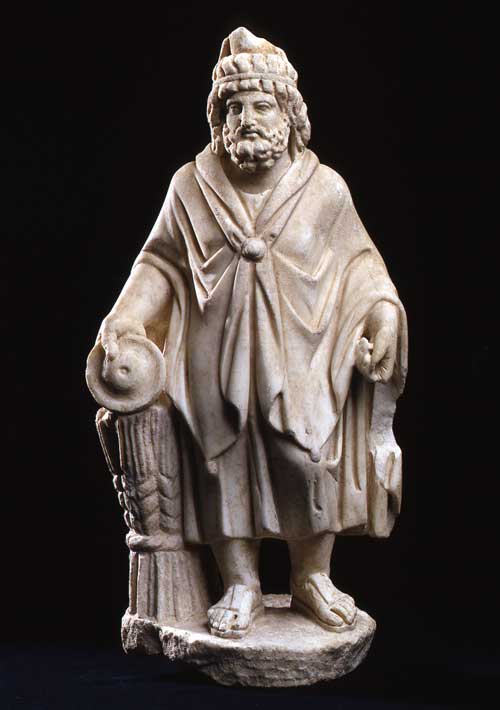Marble Sculpture of Saturn-Baal, 100 CE - 400 CE
Marble
height 47 cm
height 18 1/2 in
height 18 1/2 in
X.0502
The Carthaginian 'triad' of important gods include Baal Hammon, Tanit, and Eshmun. The word Baa (pronounced ba-al) meant 'lord' in Phoenician and was the term used in the Old Testament...
The Carthaginian 'triad' of important gods include Baal Hammon, Tanit, and Eshmun. The word Baa (pronounced ba-al) meant "lord" in Phoenician and was the term used in the Old Testament to refer to an Canaanite god. Baal bears the titles "Rider of the Clouds," "Almighty," and "Lord of the Earth." He was the god of the thunderstorm, the most vigorous an aggressive of the gods, and was believed to reside on Mount Zaphon, in Phoenicia. Archaeological evidence on Baal Hammon includes sacrificial pits in his temples, where victims usually first-born sons were burnt in his honor.
This was, in fact, a fairly common practice in most of the Mediterranean area, and is noted frequently in the Old Testament (notably amongst the Egyptians and the Carthaginians). His temples were also associated with holy prostitution. The Roman god Saturn was the main deity of agriculture (protector of seeds and sowers) and was associate with the Greek god Kronos. The mythologies of the two gods are therefore intertwined to no little extent, and become more complex once the older Carthaginia god Baal (Hammon) became associated with both Saturn and Kronos during the Greek and Roman imperia expansions of the late first millennium BC. This culture clash led to a fusion of modern and ancient traditions as invaders struggled to impose their culture upon conquered but not defeated societies.
The uneasy truce has many archaeological manifestations: a notable example is the Roman habit of being mummified in the traditional Egyptian style.
Such evidence is rare and highly significant, denoting major social developments in the Mediterranean basic that would go on to affect much of the known world.
This sculpture is an elegant embodiment of those troubled times. Standing 18.5 high, this statue represents Saturn/Baal in traditional garb, with a tunic overlaid by a toga. The drapery is very finely carved, and i gathered in the mid-chest with a small round brooch. His face and beard are extremely detailed an beautifully executed, and are topped with a soft clot hat bound at the brows with a cord. His features are cast in an expression of pensive reflection. His feet are shod with sandals. His right-hand rests upon bale of barley, and he is holding a circular object possibly a discus in his right hand. His left hand has suffered some damage, but probably originally held a scythe an implement associated with both Saturn and Kronos (and, incidentally, the inspiration behind Deaths wielding of a scythe in his role as the grip reaper). Judging from the sculptures size, it was probably a domestically-owned household god, kept in niche in a private home of substance in order to cast benedictions upon the householders. This is genuinely beautiful sculpture, and also one o considerable importance to anyone interested in the dynamics of the Mediterranean crucible in which the roots of western civilisation were forged.
This was, in fact, a fairly common practice in most of the Mediterranean area, and is noted frequently in the Old Testament (notably amongst the Egyptians and the Carthaginians). His temples were also associated with holy prostitution. The Roman god Saturn was the main deity of agriculture (protector of seeds and sowers) and was associate with the Greek god Kronos. The mythologies of the two gods are therefore intertwined to no little extent, and become more complex once the older Carthaginia god Baal (Hammon) became associated with both Saturn and Kronos during the Greek and Roman imperia expansions of the late first millennium BC. This culture clash led to a fusion of modern and ancient traditions as invaders struggled to impose their culture upon conquered but not defeated societies.
The uneasy truce has many archaeological manifestations: a notable example is the Roman habit of being mummified in the traditional Egyptian style.
Such evidence is rare and highly significant, denoting major social developments in the Mediterranean basic that would go on to affect much of the known world.
This sculpture is an elegant embodiment of those troubled times. Standing 18.5 high, this statue represents Saturn/Baal in traditional garb, with a tunic overlaid by a toga. The drapery is very finely carved, and i gathered in the mid-chest with a small round brooch. His face and beard are extremely detailed an beautifully executed, and are topped with a soft clot hat bound at the brows with a cord. His features are cast in an expression of pensive reflection. His feet are shod with sandals. His right-hand rests upon bale of barley, and he is holding a circular object possibly a discus in his right hand. His left hand has suffered some damage, but probably originally held a scythe an implement associated with both Saturn and Kronos (and, incidentally, the inspiration behind Deaths wielding of a scythe in his role as the grip reaper). Judging from the sculptures size, it was probably a domestically-owned household god, kept in niche in a private home of substance in order to cast benedictions upon the householders. This is genuinely beautiful sculpture, and also one o considerable importance to anyone interested in the dynamics of the Mediterranean crucible in which the roots of western civilisation were forged.
